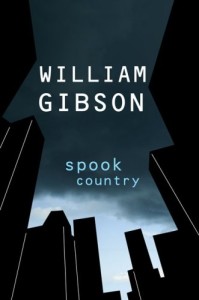 One of the characters in William Gibson’s new book Spook Country is addicted to a particular kind of tranquilizer. During the book’s course he takes two slightly different versions of it, with different brand names. I was curious about just what kind of drug it was, so I did what I’m pretty sure Gibson wants his readers to do: I Googled it. Of the entries that appeared, I chose the one in Wikipedia, and learned that the drug is in the same family as Valium. And under the section titled “Popular culture references to. . . .” I found, indeed, a reference to William Gibson’s new book Spook Country. This was, you understand, within days of the book’s official publication date.
One of the characters in William Gibson’s new book Spook Country is addicted to a particular kind of tranquilizer. During the book’s course he takes two slightly different versions of it, with different brand names. I was curious about just what kind of drug it was, so I did what I’m pretty sure Gibson wants his readers to do: I Googled it. Of the entries that appeared, I chose the one in Wikipedia, and learned that the drug is in the same family as Valium. And under the section titled “Popular culture references to. . . .” I found, indeed, a reference to William Gibson’s new book Spook Country. This was, you understand, within days of the book’s official publication date.
That’s a perfect metaphor for what Gibson is doing and saying in Spook Country. “All reality is virtual” is as close as I can come to summarizing his main theme.
Spook Country is set in the U.S. in the present. As in right now, today. It’s more of an espionage thriller than any of his previous books, although it draws on many of the same cyberpunk concepts he helped to pioneer — it’s just that they’re played out in today’s real world setting. Although, as I noted, the message is “all reality is virtual,” and all is definitely not as it seems.
The protagonist is Hollis Henry, a former rock star now several years out of the scene and trying, not very successfully, to make it as a journalist. That seems to be changing when she gets a job chronicling the latest mashup of art and technology, “spatially tagged hypermedia.” It combines virtual-reality artworks with GPS technology so that someone wearing wired goggles will see the artwork overlayed on a specific location. One of them involves River Phoenix’s body on the sidewalk outside the storefront where he died; another, a field of white crosses representing American casualties in the Iraq war.
A second story thread involves Tito, a young man of Cuban-Chinese descent living, probably illegally, in New York. He is a member of an extended family that does some shadowy sorts of jobs, and Tito’s current one seems to involve handing off iPods to a gentleman he calls “the Old Man.”
Tito is being followed by a fellow we know as Brown. We see Brown through the eyes of Milgrim, the addict mentioned at the beginning of this review. Milgrim seems to be a former university professor, perhaps of linguistics, or maybe a former U.N. translator. But now he’s just a junkie. He has been pressed into service by Brown, who doles out pills to him in exchange for his services, translating the arcane language Tito and his family use in their text messages.
There’s one other major player, a Belgian named Bigend, who is ostensibly the publisher of the magazine Holllis is writing for. Except, nobody has ever heard of the magazine, or the company, Blue Ant, that it’s part of. When Bigend admits to Hollis that the article she is working on is really some sort of clandestine operation, she’s fascinated enough to stick with it in spite of the danger.
That’s all of the plot I’ll divulge. Suffice to say, you won’t know who are the bad guys and who are the good guys until right up to the end. And even the ending leaves open the question of whether one major player was actually just a gadfly or perhaps the one who was manipulating everything from behind the scenes. This, of course, is yet another manifestation of the theme. These characters dream and hallucinate, they hear voices and see things that maybe aren’t there, remember memories that may be false.
I had a hard time putting Spook Country down. The chapters are short, the action punchy and almost non-stop. Explication is handled adroitly. And several times I laughed out loud, at situations and at the clever writing.
That’s not to say it’s perfect. I found myself annoyed at the sheer volume of person and place references. Chases in New York don’t take happen in generic locations, but in actual hotels, parks and squares. Artists’ workspaces are placed on named streets, and people eat in real restaurants. It sometimes felt as though Gibson was trying too hard to incorporate hip place references. On the other hand, the attention to detail is what gives the story its aura of reality. The level of Gibson’s knowledge about seemingly useless trivia — such as how to jigger an electrician’s zip-tie — and his ability to make such trivia work for the story, is astounding.
In the end, I found the climax anti-climactic. Spook Country ends more with a whimper than a bang. It’s not bad, it’s just a little disappointing, although in one sense that makes it even more like today’s news. There’s no real resolution. Stuff just keeps happening.
Putnam, 2007
